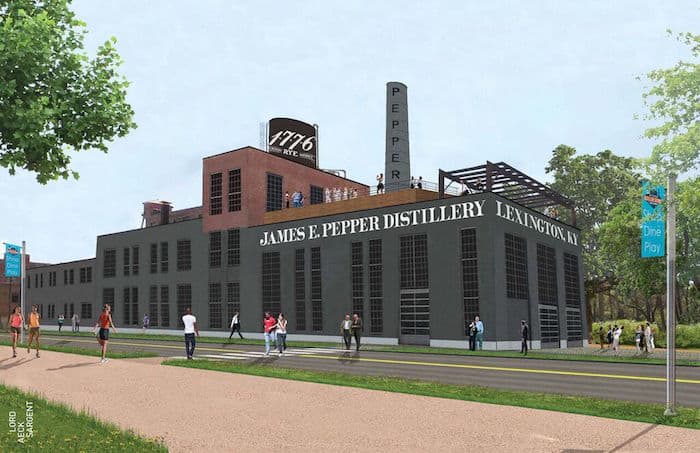Old Frankfort Pike is as beautiful a stretch of backroad blacktop as that found anywhere. Running roughly between I-64 and Lexington, Kentucky, “OFP,” a.k.a. Hwy 1681, winds past horse farms so meticulously maintained that humans envy the lifestyles of the equine athletes galloping in the fields.
Yet then, for no clear purpose, the road’s name becomes Manchester St. just outside Lexington’s city limits and at the location of James E. Pepper Distilling Co. The massive derelict complex, abandoned in 1958 when the distillery closed, has been locals’ unofficial choice to host a haunted house. But in 2013, developers began its conversion into an entertainment site.
Today, a restaurant, an ice creamery, a brewery, and a micro-distillery operate in one portion of the complex, and in 2017, the James E. Pepper Distillery will open as the anchor tenant. The opening will mark the return of the Pepper brand to the 27-acre site where Col. Pepper’s first operation tapped Town Branch Creek for its limestone water in 1879. As happened under Pepper’s watch, current owner Amir Peay’s tourism-minded micro-distillery will produce rye and bourbon.

Pepper’s parent company, the Georgetown Trading Co. (GTC), acquired the trademark for the historic brand eight years ago. Using contract distillers such as Corsair in Bowling Green, Kentucky, and MGP in Lawrenceburg, Indiana, Peay’s overseen production of a six-item line of Pepper bourbons and ryes that are bottled in Bardstown, Ky. He’s also contracted a brewer to produce and bottle James E. Pepper ale.
Nearly nine years ago, GTC acquired its first spirits property, John L. Sullivan Irish Whiskey. Soon after, Peay, eager for another acquisition, discovered Pepper and became fascinated with its history, especially the near-disappearance of the prominent brand.
“You could find history about it,” he said, “but it wasn’t all in one nice, neat place with a ribbon around it. When I learned it was defunct and that no one held the trademark, I saw an opportunity to revive it myself.”
His Pepper whiskeys have racked up one Double Gold and three Gold medals at recent San Francisco World Spirits Competitions, giving Peay the confidence to expand production by building his own facility. Still, he expects production there to be so minor compared to the capacity at MGP, now Pepper’s sole contract distiller, that the Lexington plant’s distillate will be blended with that produced in Lawrenceburg.
“The amount of whiskey produced there will be small, probably about three barrels per shift to start,” Peay said. “Blending distillate from Lexington with the existing product line will produce some interesting flavors and tie into the provenance of the new Pepper distillery.”
He said projections for annual capacity will near 700 barrels, and that like many distilleries, the Pepper visitors center will feature a limited selection of whiskeys aged and sold only there.
“With what we’re putting in, we could go higher; there’s a lot of capacity there,” he said. “But in the short term, we have no intention to replace our partners. We sell a great award-winning whiskey at a great value, and we have no reason to change that.”
Peay said whiskey enthusiasts should expect “a great visitors experience” that includes a modest museum filled with historic Pepper artifacts and memorabilia he’s collected since acquiring the Pepper trademark. Among those finds are perfectly preserved Pepper bottles from before, during, and after Prohibition; 120-year-old letters from Col. James. E. Pepper himself; and detailed mechanical drawings from when the distillery was upgraded in 1934, at Prohibition’s end.
Thanks to Kentucky’s updated laws that now allow for the sale of alcohol at a distillery, the 10,000 square-foot space will feature a cocktail bar and tasting area.
“When I visited that site eight years ago, it was bombed out, just awful,” Peay said. “I consulted the best distillery engineers in the state to talk about bringing it back, and they tried to talk me out of it. But the owners of the space are very proud of what they’ve done there, and I have no doubt we’ll add to that.”








